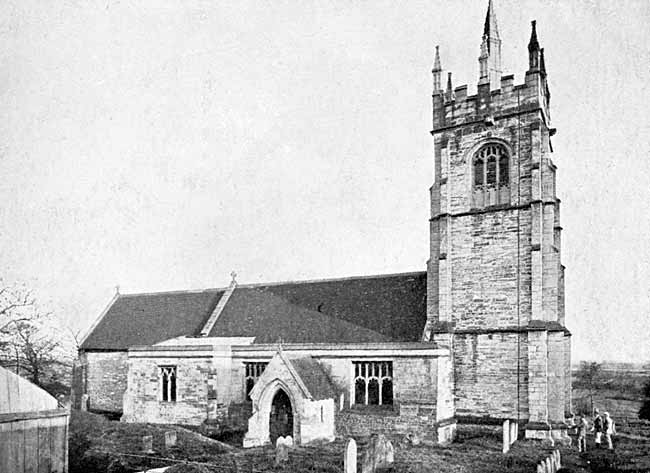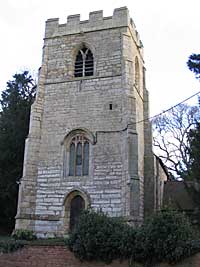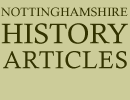ABOUT NOTTINGHAMSHIRE: ITS PLACES AND ITS PEOPLE,
by CORNELIUS BROWN, F.R.S.L., author of "LIVES OF NOTTS. WORTHIES" and
other works.
Chapter XLVII. Some minor villages and their curiosities.
UPTON AND ITS CHURCH—CURIOUS DISCOVERY—EARTHENWARE POTS IN THE WALLS—THE BISHOP'S DESCRIPTION—FROM UPTON TO HOCKERTON—A PICTURESQUE COUNTRY—THOROTON'S CONNECTION WITH HOCKERTON

St Peter's church, Upton (c.1905).
A couple of miles from Southwell, on the summit of a hill which commands a fine view of the Trent, Valley, is the little village of Upton. It is one of the very few places in the county to which our great historian Thoroton has paid no attention, and yet it is not without some features of interest to the Antiquary, while lovers of the picturesque will find in the country hereabouts a good deal that will afford them satisfaction and enjoyment. The church, which is a prominent feature in the landscape, has a substantial Perpendicular tower crowned by eight pinnacles, and having in the centre a lofty master pinnacle which rises above its neighbours, and so adds materially to the effect. In the sacred edifice, restored with much care and good taste, examples of Perpendicular and Decorated styles of architecture may be noticed, and there is a small chapel on the north side, with two sepulchral arches beneath which, some years ago, an altar slab was found. No memorials of any antiquity remain, but in Throsby's time there was a brass in the chancel, of which he has fortunately preserved a drawing. From the inscription it would appear that there were two originally, those of a man and his wife, Agnes and John, and that the latter died in 1460.
 |
BRASS, FORMERLY AT UPTON. |
 |
Throsby mentions, as a singular cirumstance, that about the time of his visit to Upton in 1796 there were just as many inhabitants as there were days in the year. It was one of those coincidences in which the venerable Throsby delighted, but a still more notable fact is happily placed upon record by that eminent antiquary, the Bishop Suffragan of Nottingham, in a paper read at the Newark meeting of the Lincoln Diocesan Architectural Society in 1871. His Lordship says, "When the chancel of Upton Church was rebuilt in 1863, 6 rude earthenware pots were found embedded in the walls of the old structure of the Decorated period. These were placed 3 on each side, at intervals of about 6 feet and 7 or 8 feet above the floor, with their mouths facing outwardly, but covered with plaster. One of these is preserved, from which the accompanying cut is copied. It is of pale red ware and 91/2 inches high, No doubt these pots were employed for acoustic purposes after a very ancient custom; this method of increasing resonance having been adopted both by the Greeks and Romans in their theatres and other public buildings, and Vitruvius, lib. v. cap. 5, makes mention of bronze as well as clay vessels used for this purpose. Sometimes they were employed in the construction of domes, as in the case of the tomb of the Empress Helena on the Via Labicana, a mile and a half beyond the Porta Maggiore, at Rome, in the dome of which many terracotta amphora) were inserted. These were placed in a double row encircling it below, and a single row above. They were of the usual form employed by the Romans for containing wine, having narrow necks, small ears or handles, and terminating in a point below. In England pots were found embedded in the base of the choir screen of Fountains Abbey in 1854, and as some ashes were observed within them, it was suggested that they might have served for warming purposes, although, this is not probable. In St. Peter Mancroft, Norwich, jars were found under the choir stalls in 1850. These were buried in the outer walls of the choir and dwarf walls supporting the fronts of the stalls, with their mouths opposite to one another and opening into the space between them, which was paved with yellow glazed tiles. These jars, 26 in number, were 91/2 in. high and their mouths were 61/2 wide. In St. Peter per Mountergate Church, Norwich, a similar discovery was made in 1860 beneath the choir stalls. These vases had handles and were evidently intended for domestic use; some were 12 and others 10 inches high. Some similar jars were also found in St. Mary's Church, Youghal, in the County of Cork. These were inserted in its walls at a height of 23 feet from the ground." If no other circumstance than the discovery of these curious pots gave an interest to Upton Church, this certainly would, and we are much indebted to the learned Bishop for his graphic account. But the sacred edifice has other notable features to which we have referred, while the village itself can claim amongst its worthies no less eminent a Scholar than the late Professor Tennant, mineralogist, who was born there in 1808.
From Upton a pleasant drive through a country affording charming views of hill and valley, past Averham Park once the palatial abode of the Lords Lexington, and. now a substantial farmhouse, brings us to the still smaller village of Hockerton, with its rectory and church embowered in trees. Like its neighbour at Upton the church has been well restored, and is evidently very carefully and reverently tended. In the churchyard are two of the largest and oldest yew trees in the county, which have been well described as "picturesque adjuncts" of the "God's acre" which they partially overshadow and adorn. Entering the south porch we notice a large stoup near the door, and within, the church is an old alms box of solid oak. There are some remains of Norman work visible, and on the south side of the chancel an arched recess, in the centre of which a small niche has been inserted. The end of one of the old benches of late Elizabethan work has been preserved, and the tops of the new benches are appropriately modelled after this pattern in poppy-head design. There are no memorials save a modern mural tablet, but in the tower is part of a slab to a former rector, temp. 1486.
 St Nicholas's church, Hockerton (photo: Andrew
Nicholson, 2005).
St Nicholas's church, Hockerton (photo: Andrew
Nicholson, 2005).To Hockerton Thoroton has devoted more than ordinary attention, inasmuch as a large portion of it belonged to Gilbert Boune, his father-in-law. It appears from his record, that in the twelfth and thirteenth centuries, various gifts were made by property owners, to the Abbey of Rufford. Hubert de Hokerton gave to the monks four selions of land, but in return they were to grant him their brotherhood, and after his death to do for him as for a convert. And with a due regard for his bodily as well as his spiritual welfare, he stipulated that the monks should provide him each year at Michaelmas a pair of shoes or 4d.—the shoes, no doubt, preferred. It was customary in those times to sign with a seal, but Master Hubert did not possess one, so he borrowed that of the chapter of Southwell, and caused it "for a testimony," to be hung at his chartel. Following the family who took their name from the village, came the Butilers, who were at Hockerton until the days of Henry VII., and another old family who also held property in the parish at a similiar period was the family of Criche. In the time of Henry VI., the Criches sold their lands to John Hunt, Merchant of the Staple, and from him they descended in part to Isabell, wife of Edward Boun, grandfather of Gilbert Boun, serjeant-at-law, and father of Mrs. Thoroton. Beyond the dry-as-dust details of the transfer of property there is nothing more to be said, and the registers contain no entries of any special interest.
